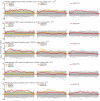Malignant germ cell tumors display common microRNA profiles resulting in global changes in expression of messenger RNA targets
- PMID: 20332240
- PMCID: PMC3000593
- DOI: 10.1158/0008-5472.CAN-09-3301
Malignant germ cell tumors display common microRNA profiles resulting in global changes in expression of messenger RNA targets
Abstract
Despite their extensive clinical and pathologic heterogeneity, all malignant germ cell tumors (GCT) are thought to originate from primordial germ cells. However, no common biological abnormalities have been identified to date. We profiled 615 microRNAs (miRNA) in pediatric malignant GCTs, controls, and GCT cell lines (48 samples in total) and re-analyzed available miRNA expression data in adult gonadal malignant GCTs. We applied the bioinformatic algorithm Sylamer to identify miRNAs that are of biological importance by inducing global shifts in mRNA levels. The most significant differentially expressed miRNAs in malignant GCTs were all from the miR-371-373 and miR-302 clusters (adjusted P < 0.00005), which were overexpressed regardless of histologic subtype [yolk sac tumor (YST)/seminoma/embryonal carcinoma (EC)], site (gonadal/extragonadal), or patient age (pediatric/adult). Sylamer revealed that the hexamer GCACTT, complementary to the 2- to 7-nucleotide miRNA seed AAGUGC shared by six members of the miR-371-373 and miR-302 clusters, was the only sequence significantly enriched in the 3'-untranslated region of mRNAs downregulated in pediatric malignant GCTs (as a group), YSTs and ECs, and in adult YSTs (all versus nonmalignant tissue controls; P < 0.05). For the pediatric samples, downregulated genes containing the 3'-untranslated region GCACTT showed significant overrepresentation of Gene Ontology terms related to cancer-associated processes, whereas for downregulated genes lacking GCACTT, Gene Ontology terms generally represented metabolic processes only, with few genes per term (adjusted P < 0.05). We conclude that the miR-371-373 and miR-302 clusters are universally overexpressed in malignant GCTs and coordinately downregulate mRNAs involved in biologically significant pathways.
Figures




References
-
- Palmer RD, Nicholson JC, Hale JP. Management of germ cell tumours in childhood. Current Paediatrics. 2003;13:213–20.
-
- Palmer RD, Barbosa-Morais NL, Gooding EL, et al. Pediatric malignant germ cell tumors show characteristic transcriptome profiles. Cancer Res. 2008;68(11):4239–47. - PubMed
-
- Teilum G. Classification of endodermal sinus tumour (mesoblatoma vitellinum) and so-called “embryonal carcinoma” of the ovary. Acta Pathol Microbiol Scand. 1965;64(4):407–29. - PubMed
-
- Esquela-Kerscher A, Slack FJ. Oncomirs - microRNAs with a role in cancer. Nat Rev Cancer. 2006;6(4):259–69. - PubMed
-
- Giraldez AJ, Mishima Y, Rihel J, et al. Zebrafish MiR-430 promotes deadenylation and clearance of maternal mRNAs. Science. 2006;312(5770):75–9. - PubMed
Publication types
MeSH terms
Substances
Grants and funding
LinkOut - more resources
Full Text Sources
Other Literature Sources
Molecular Biology Databases

